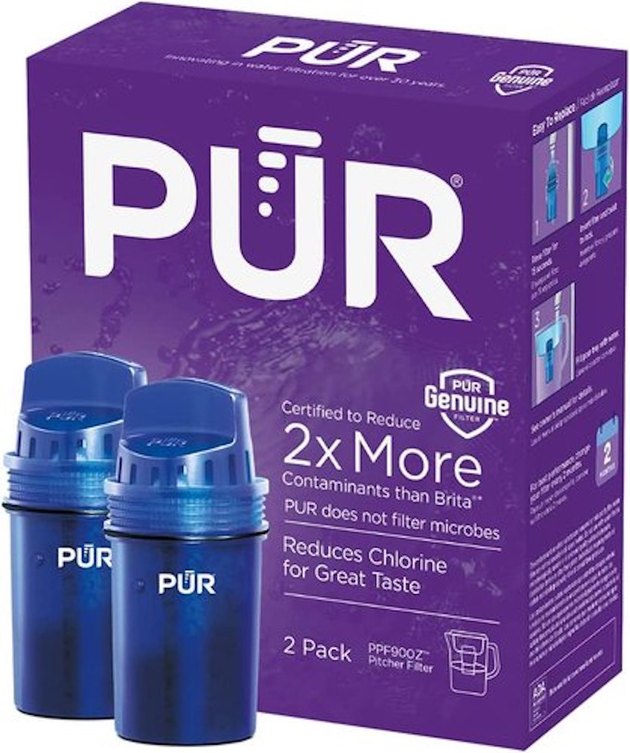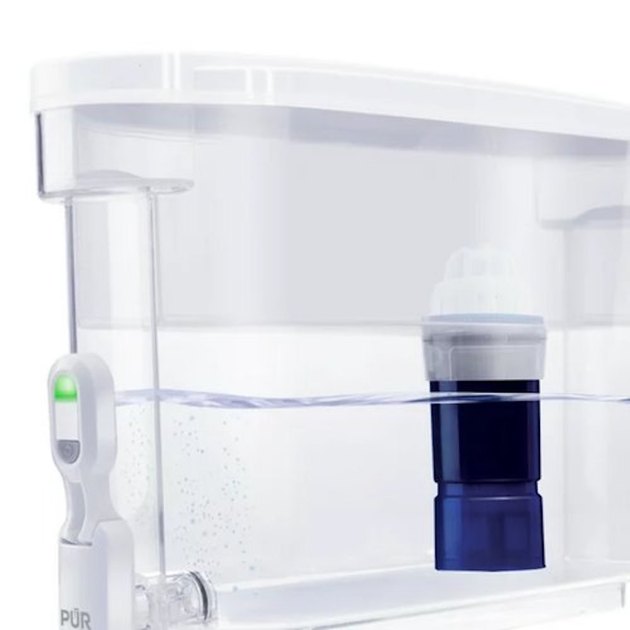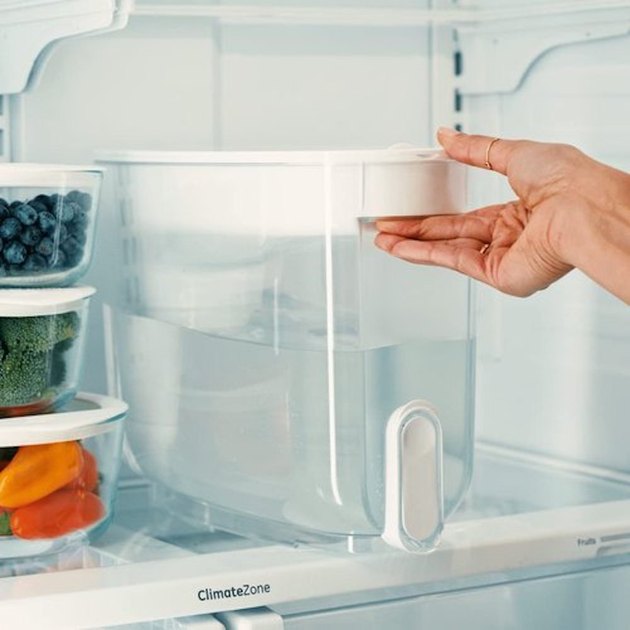
How's your water? The tap water that comes from your faucet should be safe to drink in most parts of the country, but that doesn't mean it necessarily tastes great or makes a good cup of coffee or tea. A relatively simple and inexpensive water filter, with its accompanying pitcher or dispenser, can make that problem go away. More sophisticated filtration systems can deal with genuinely hazardous contaminants in your water, if that should become a problem where you live. There are lots of confusing claims and different designs with these products, but we've got your back. We picked out six of the best water filter pitchers and dispensers for you to consider and explain what you need to know about them.
What to Consider When Purchasing Water Filter Pitchers and Dispensers
Video of the Day
There are lots of ways to improve your water, but some of them—like an under-sink filtration system or a reverse osmosis system—require a significantly higher up-front investment and may need professional installation. We won't be looking at those systems in this review, because they're in a whole other ballpark. Filtered water pitchers and dispensers are good enough for most uses, they're easy to use and don't usually have large up-front costs.
Video of the Day
Things to consider when you're purchasing a water filtering system include:
Water Quality: Before you choose a filter, you need to know what you want from your filtration system. Barring infrastructure failures or a natural disaster, municipal water systems in the U.S. generally provide tap water that's safe for human consumption. In that case you might only need a filter that'll make your drinking water taste better.
If you're on a well, you may have more contaminants to contend with. Municipal water quality reports are a matter of public record (search your community's name, along with the phrase "water confidence report"), but if you're a well user, you'll need to pay privately to have your water tested. Once you know what you'd like to filter from your water, you'll know how elaborate a water filtration system to buy.
The Filter: A filtration system is, naturally, only as good as its filter. A standard filter is fine if you already have clean water and just want to improve its flavor or remove chlorine. If you're concerned about specific contaminants such as heavy metals or pesticides, you'll want need a more sophisticated filter that's ANSI/NSF certified to remove those specific contaminants. Some take longer than others to filter a given quantity of water, especially the higher-end models that extract more contaminants.
You'll also want to consider the filter's lifespan (about 40 gallons, for the most popular models from Brita and PUR) and the cost of filter replacement. In the long run, it's the cost of filters—not the initial purchase price of the system—that represents most of the money you'll spend on improving your water supply.
Its Capacity: How much filtered water do you expect to go through in a day? If you're using it just to pamper your houseplants, you may be able to get by with a relatively small carafe that holds 2 or 3 cups of water. Larger pitchers can hold a quart or two and in-fridge dispensers hold over a gallon. Some companies make countertop water filters with even larger capacities, though their bulk makes them less appealing for most users. If you're looking for high volume, and don't sweat the water being refrigerated, a faucet mounted filter might be a better option.
Ergonomics: Although your filter's capability is the most important part of the equation, ergonomics are also important. Each pitcher or dispenser (and to a lesser extent, the filter itself) is a physical object you'll need to handle, and its design can make that easier or harder. How does the pitcher feel in your hand? Is it easy to refill? Will you struggle to carry and pour from it when it's full? Will a given dispenser fit neatly into your fridge? Is the pitcher or dispenser (and more specifically its filtration chamber) easy to clean, or even dishwasher safe? All of these (especially ease of use) will have an impact on how much you love your purchase.

NSF Certification and Standards
The top brands on the market are usually NSF-certified. That means they've been tested by the National Sanitation Foundation (using tests developed jointly with the American National Standards Institute) or the Water Quality Association (WQA), which is a really rigorous process. It's also time-consuming and costly, to a degree that puts NSF certification out of the reach of many newer or smaller companies. They may advertise their products as "tested to NSF standards," which is not the same thing. It means a non-NSF lab has done the testing, and it may or may not have been done well.
If the testing was done at a reputable lab, and there's a lot of transparency about the testing process and its results, that's an outcome you can still feel comfortable about. If the testing was done in-house by the manufacturer, that's less compelling and a clear case of "buyer beware." There are also international standards that are just as rigorous and authoritative as the NSF's, but you aren't as likely to encounter them with products sold in America.
The three NSF standards you'll see cited most often are:
- NSF Standard 42: This one covers cosmetic problems such as taste and odor, which are unpleasant but won't affect your health. They'll remove things like chlorine or silt.
- NSF Standard 53: Filters with this certification can remove harmful EPA-regulated contaminants like lead, cadmium or mercury, which are known to have adverse health effects. There's a catch, though: Filters are tested and certified separately for each individual pollutant, so brand A might be certified for lead reduction, while brand B is certified for benzene and other heavy metals but not lead. You'll need to carefully read each manufacturer's product literature to make sure that your specific water contaminants will be removed by the filter you buy.
- NSF Standard 401: This is the "emerging contaminants" standard, which covers contaminants that (unlike those in Standard 53) aren't yet regulated by the EPA. It includes things like pharmaceuticals, microplastics and so-called "forever chemicals."

The Best Everyday Water Filter
If you're looking for a basic everyday water filter, the kind that just makes your water taste better, your choices are all pretty similar. The leading brands use a carbon filter that binds chemically with impurities, removing them from the water. What makes the PUR our top pick, over Brita and other competitors, is smarter design. While they're functionally pretty equivalent, the Brita filter is simply held in place by gravity.
The PUR, by contrast, must be pushed and given a twist in order to lock it into place. You'll unquestionably know when the filter is properly installed, whereas with the Brita you'll only know if the water flows through into the pitcher much more quickly than it should. You also won't have to worry about the filter falling out as you pour the last cup of water from your pitcher, something that can happen with other brands.
The Best Water Filter for Additional Pollutants
If you have the misfortune to live in an area where there are substances of concern in your drinking water, you're going to want a filter that can deal with them. These Elite filters will do that. Like the Brita Longlast filters they've replaced, they'll give you a 99% lead reduction and also meet the NSF's Standard 53 for a wide range of contaminants including cadmium, mercury and benzene. Overall, it removes slightly more contaminants than the comparable PUR filter (though the companies regularly leapfrog each other in that respect), and it's also quicker to filter your water.
A bigger point is that, while the Brita Elite costs about twice as much as basic filters, it will clean 120 gallons of water—roughly three times the filter life you'd get with basic models from PUR and Brita itself, and six times as much as filters from ZeroWater—which means it's actually more economical to use despite the higher price. You may still opt for a basic filter, especially if you have good water to begin with, but if you need to upgrade it won't break the bank.
The Best Water Filter Pitcher
Most of the big brands produce an 11-cup pitcher and a 7-cup pitcher, for households with larger or smaller water consumption. We've opted for an11-cup model, which will make more sense for most households (more water at a time for thirsty teens or refilling water bottles). Realistically, your choice of filter will dictate your choice of pitcher—they're not interchangeable—but ergonomically, this one from PUR gets the big stuff right. Its handle is comfortable, and the filter chamber's lid has a thumb lever for one-handed refilling. The filter chamber is also opaque, so you can see how much water is still left to trickle through.
It comes with PUR's Plus filter, which removes lead and other contaminants, which is a bonus but means water will be slower to filter. If your water is good, you can replace it with PUR's basic pitcher filters and get your drinking water more quickly. If you settle on Brita filters or another leading brand you'll of course use their pitcher instead, but PUR's design is definitely more thoughtful. It's even dishwasher safe for easy cleaning.
The Best Water Filter Dispenser
If you go through a lot of water, the price difference between a pitcher and a dispenser is minimal but the difference in capacity is not. This model from PUR holds 30 cups in total, 18 in the dispenser itself and 12 more in the filtration chamber (the competitive Brita model only counts the 18 in the dispenser proper, but also holds 30 when fully topped up). That means you can fill it to the brim in one trip to the sink, and then leave it in the fridge until everything's empty.
There's little to choose between the PUR and the Brita, but—as with their respective pitchers—PUR's just a bit more ergonomic. For one thing, its handles are deeper, so it's easier to carry when you're toting it back to the fridge from the sink and it has a prominent indicator light right on the spigot to tell you when to replace your filter. Like the pitcher it has a see-through filtration chamber, so you can see how much water is left. It's also slightly narrower and shorter than the Brita, so it takes up the full depth of your fridge shelf but less of the width. The only catch is that it might not quite fit some smaller or shallower fridges, in which case you might need to opt for a rival brand.
The Best Water Filter Dispenser for Well Water
Big players Brita and PUR have a lot of things in common, and one of them is that they're designed to work with water that's relatively clean to begin with. If you're on a well, or have very hard water with lots of mineral content, you may find that your filters clog regularly. That won't be an issue with the Lifestraw, which is designed to handle relatively dirty water. It also has a radically more capable filter, which is capable of removing bacteria, parasites, microplastics, pharmaceuticals and a laundry list of other contaminants.
It uses a two-filter system, with a carbon filter (similar to Brita's or PUR's) for most impurities and a membrane filter to remove bacteria, parasites and silt or sediment. The carbon filter needs to be replaced after 40 gallons, like most others, but the membrane filter lasts a year between changes. No other filter in our review can remove bacteria and parasites, so if you live in an area where water quality is shaky and boil-water orders are common, it's definitely the right one to buy.
The Best Water Filter Dispenser for Emergencies
If you're a "hope for the best but plan for the worst" kind of person, or if your family spends a lot of time camping, you may want to consider keeping a Lifestraw water purifier on hand. While it doesn't match the Lifestraw dispenser in the sheer breadth of contaminants it removes, it targets the specific ones you'll be concerned about during an emergency or a camping trip: Bacteria, parasites and viruses. That's why Lifestraw describes it as a water purifier, rather than simply a filter. You simply hang the 18-liter container (over a gallon) and fill it with water, then position the filter nozzle over your drinking glass or water bottle.
Filter life is exceptional as well, at over 4,700 gallons compared to a normal filter's 40 gallons (it'll supply a family of four for three years or so before it needs to be replaced). If you live in an area where major storms and disasters are common, or want a high capacity dispenser that's more suited to daily use as well as emergency use, consider upgrading to the Lifestraw Community. Its price tag is higher but it holds and dispenses more water, filters more pollutants, and can purify 26,000 gallons between filter changes. That's enough to supply up to 75 people for three years or more.





